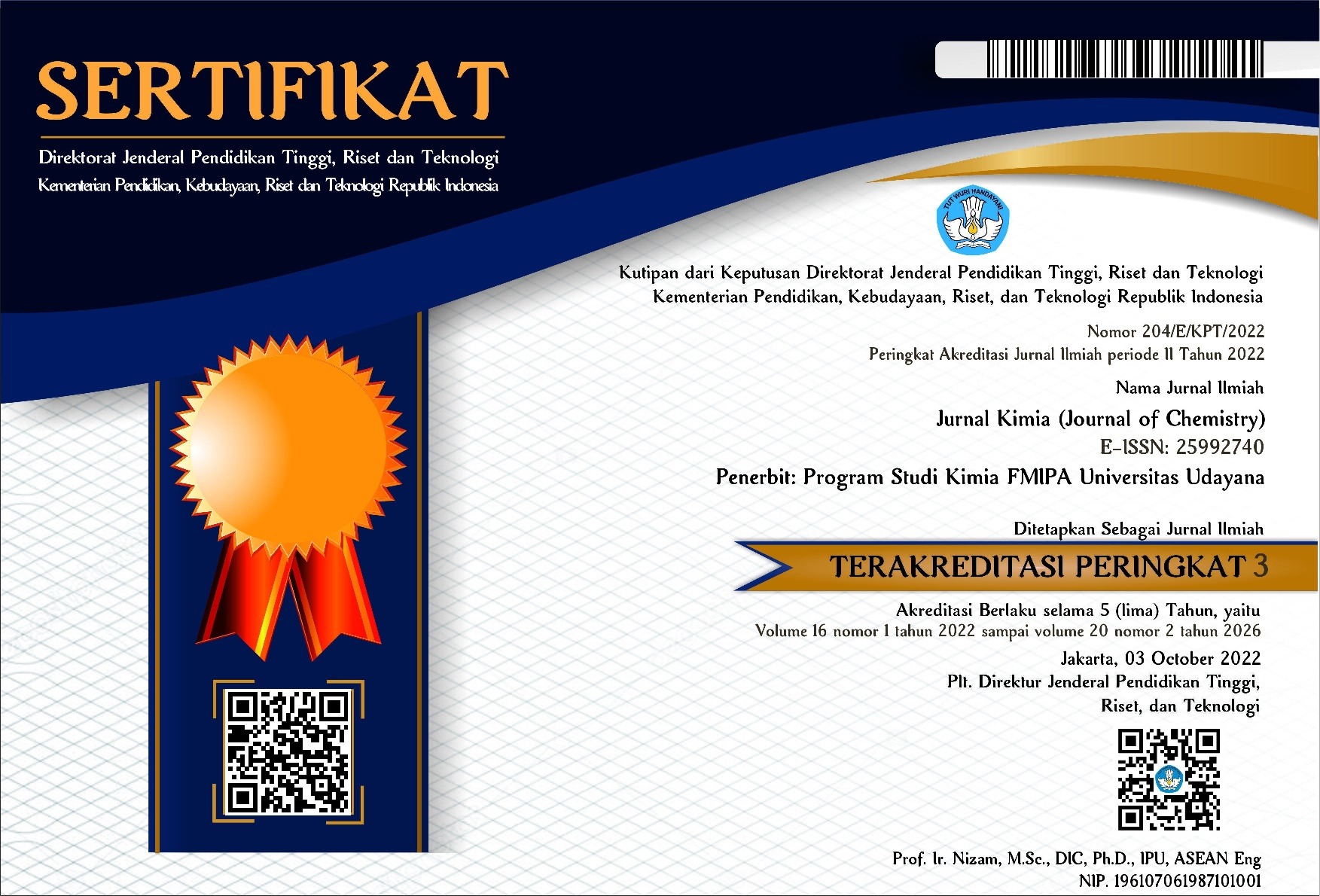BIOSINTESIS DAN KARAKTERISASI NANOPARTIKEL PERAK MENGGUNAKAN EKSTRAK TANGKAI DAUN MBOTE (Colocasia esculenta L) SERTA UJI AKTIVITAS KATALITIKNYA TERHADAP REAKSI REDUKSI ZAT WARNA SINTETIK
Abstract
Penelitian ini menggunakan ekstrak tangkai daun Mbote (Colocasia esculenta L.) untuk mensintesis nanopartikel perak (AgNp) dan mengetahui pengaruh konsentrasi larutan AgNO3, volume ekstrak, pH, dan waktu penyimpanan terhadap stabilitas AgNp yang terbentuk pada suhu kamar. Variasi konsentrasi AgNO3 1,0 hingga 8,0 mM dan volume ekstrak 0,25 hingga 2,00 mL digunakan untuk sintesis. Pengaruh pH pada stabilitas AgNp pada suhu kamar dipelajari dengan variasi pH 1-11 dan lama penyimpanan 1 jam hingga 1 bulan. Karakterisasi AgNps dilakukan menggunakan Spektrofotometer UV-Vis, FTIR, dan TEM. Uji aktivitas katalitik dilakukan dengan mereaksikan 10,00 mL Methylene Blue (MB), Methyl orange (MJ), dan Rhodamine B (RB) dengan 1,00 mL NaBH4 (2000 mg/L) dan 1.00 mL AgNp. AgNp yang terbentuk memiliki diameter rata-rata 9,845 ± 3,142 nm berdasarkan gambar TEM. Konsentrasi AgNO3 optimum adalah 5,0 mM, dan volume ekstrak adalah 1,00 mL. Kondisi pH yang berbeda menghasilkan warna dan konsentrasi AgNp yang berbeda. Intensitas penyerapan AgNp meningkat seiring dengan meningkatnya waktu penyimpanan, dan AgNps mengendap pada 72 jam. Penggunaan AgNps untuk mereduksi MB, MJ, dan RB dapat mempersingkat waktu reaksi secara signifikan. Kinetika reaksi reduksi MB, MJ, dan RB menggunakan AgNps mengikuti model kinetika orde pertama semu dengan konstanta reaksi (kobs) masing-masing sebesar 0,0107, 0,0234, dan 0,0295 s-1.
Kata kunci : Nanopartikel perak, Colocasia esculenta L, Metilen Biru, Metil Jingga, Rhodamine B
ABSTRACT
This study used Mbote leaf stalk extract (Colocasia esculenta L.) to synthesize silver nanoparticles (AgNps) and to know the effect of the AgNO3 solution concentration, extract volume, pH, and the storage time on the AgNp stability formed at room temperature. The AgNO3 concentration variations of 1.0 to 8.0 mM and extract volumes of 0.25 to 2.00 mL were used for the synthesis. The effect of pH on the AgNp stability at room temperature was studied using pH variations of 1-11 and storage time of 1 hour to 1 month. The AgNps formed were characterized using UV-Vis Spectrophotometer, FTIR, and TEM. A catalytic activity test was carried out by reacting 10.00 mL of Methylene Blue (MB), Methyl orange (MJ), and Rhodamine B (RB) with 1.00 mL of NaBH4 (2000 mg/L) and 1.00 mL of AgNp. The AgNp formed had an average diameter of 9.845 ± 3.142 nm. The optimum AgNO3 concentration was 5.0 mM, and the extract volume was 1.00 mL. Different pH conditions produced different colors and concentrations of AgNps. The intensity of the AgNp absorption increased with longer storage time, and the AgNps precipitated at 72 hours. Using AgNps to reduce the MB, MJ, and RB could significantly shorten the reaction time. The reaction kinetics of the reduction of MB, MJ, and RB using AgNps followed a pseudo-first-order model with reaction constants (kobs) of 0.0107, 0.0234, and 0.0295 s-1 respectively.
Keywords: Nanoparticle, Colocasia esculenta L, Methylene Blue, Methyl Orange, Rhodamine B
Downloads
References
Benelli, G. 2016, December. Green Synthesized Nanoparticles in The Fight Against Mosquito-Borne Diseases And Cancer—A Brief Review. In Enzyme and Microbial Technology. 95: 58–68. Elsevier Inc. https://doi.org/10.1016/j.enzmictec.2016.08.022
Bere, M. L., Sibarani, J., & Manurung, M. 2020. Sintesis Nanopartikel Perak (NPAg) Menggunakan Ekstrak Air Daun Kemangi (Ocimum Sanctum Linn.) Dan Aplikasinya Dalam Fotodegradasi Zat Warna Metilen Biru. CAKRA KIMIA (Indonesian E-Journal of Applied Chemistry). 7(2): Article 2.
Bozkurt, P. A. (2017). Sonochemical Green Synthesis of Ag/graphene Nanocomposite. Ultrasonics Sonochemistry. 35: 397–404. https://doi.org/10.1016/j.ultsonch.2016.10.018
Du, S., Liao, Z., Qin, Z., Zuo, F., & Li, X. 2015. Polydopamine Microparticles As Redox Mediators for Catalytic Reduction of Methylene Blue and Rhodamine B. Catalysis Communications. 72: 86–90. https://doi.org/10.1016/j.catcom.2015.09.020
Erenler, R., & Hosaflioglu, I. 2023. Green Synthesis of Silver Nanoparticles Using Onobrychis Sativa L.: Characterization, Catalytic Degradation of Methylene Blue, Antioxidant Activity, And Quantitative Analysis of Bioactive Compounds. Materials Today Communications. 35: 105863.
Garimella, R., & Eltorai, A. E. M. 2017 March. Nanotechnology in Orthopedics. In Journal of Orthopaedics. 14(1): 30–33. https://doi.org/10.1016/j.jor.2016.10.026
Inamuddin, & Kanchi, S. 2020. One-Pot Biosynthesis of Silver Nanoparticle Using Colocasia Esculenta Extract: Colorimetric Detection of Melamine in Biological Samples. Journal of Photochemistry and Photobiology A: Chemistry. 391. https://doi.org/10.1016/j.jphotochem.2019.112310
Keshav, A., Sharma, A., & Mazumdar, B. 2019. Phytochemical Analysis and Antioxidant Activity of Colocasia esculenta (L.) Leaves. 2589-9147
Kumar, S., Basumatary, I. B., Sudhani, H. P. K., Bajpai, V. K., Chen, L., Shukla, S., & Mukherjee, A. 2021, June. Plant Extract Mediated Silver Nanoparticles And Their Applications as Antimicrobials and In Sustainable Food Packaging: A State-Of-The-Art Review. In Trends in Food Science and Technology. 112: 651–666. https://doi.org/10.1016/j.tifs.2021.04.031
Kummara, S., Patil, M. B., & Uriah, T. 2016. Synthesis, characterization, biocompatible and anticancer activity of green and chemically synthesized silver nanoparticles – A comparative study. Biomedicine and Pharmacotherapy. 84: 10–21. https://doi.org/10.1016/j.biopha.2016.09.003
Mitharwal, S., Kumar, A., Chauhan, K., & Taneja, N. K. 2022. Nutritional, phytochemical composition and potential health benefits of taro (Colocasia esculenta L.) leaves: A review. Food Chemistry. 383: 132406. https://doi.org/10.1016/j.foodchem.2022.132406
Nagarjuna, R., Challagulla, S., Sahu, P., Roy, S., & Ganesan, R. 2017. Polymerizable sol–gel synthesis of nano-crystalline WO3 and its photocatalytic Cr(VI) reduction under visible light. Advanced Powder Technology. 28(12): 3265–3273. https://doi.org/10.1016/j.apt.2017.09.030
Nguyen, N., Truc, T., Nguyen, H., Nguyen, D. T., Van Su, D., Dang, C.-H., & Nguyen, T.-D. 2018. Silver and gold nanoparticles biosynthesized by aqueous extract of burdock root, Arctium lappa as antimicrobial agent and catalyst for degradation of pollutants. Environmental Science and Pollution Research. 25.
Oladoye, P. O., Ajiboye, T. O., Omotola, E. O., & Oyewola, O. J. 2022. Methylene blue dye: Toxicity and potential elimination technology from wastewater. Results in Engineering, 16: 100678.
Velgosová, O., Mražíková, A., & Marcinčáková, R. 2016. Influence of pH on green synthesis of Ag nanoparticles. Materials Letters. 180: 336–339. https://doi.org/10.1016/j.matlet.2016.04.045
Zakir, M., Gaffar, M., Lembang, E. Y., & Lembang, M. S. 2014, August. Synthesis of Silver and Gold Nanoparticles through Reduction Method using Bioreductor of Leaf Extract of Ketapang (Terminalia catappa).

This work is licensed under a Creative Commons Attribution 4.0 International License






